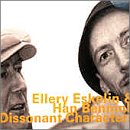| All Artists: Ellery Eskelin, Han Bennink Title: Dissonant Characters Members Wishing: 1 Total Copies: 0 Label: Hato Release Date: 1/1/1999 Album Type: Import Genre: Jazz Style: Avant Garde & Free Jazz Number of Discs: 1 SwapaCD Credits: 1 UPC: 752156053422 |
Search - Ellery Eskelin, Han Bennink :: Dissonant Characters
 | Ellery Eskelin, Han Bennink Dissonant Characters Genre: Jazz
|
Larger Image |
CD Details |
CD ReviewsTwo-man school for duo dynamics - A great record Adolph Pinelad | Montreal, Quebec Canada | 03/16/2008 (5 out of 5 stars) "This masterful record finds Eskelin (tenor sax)and Bennink (drums and percussion) face to face. And they go at it. It is a great sounding recording as is the case with all the hatHut recordings that I have heard. On this particular album it is all a question of dynamics. The greatest listening advantage is that it is quite simple to distinguish the aural effects of each instrument, since it is just the tenor sax and the drums. You can actually hear how the two musicians become instant composers along the way, creating high-energy, abstract-expressionistic session; that they broke down to individual pieces and actually named -they also spliced in two Monk tunes-. The first track sounds a bit like a warm up, or at least it works like that in my opinion. And just when you think that this album may be a dud, the high octane energy kicks in and the dynamics set in. It makes one question if the beginning is in fact a little weak, or it just takes the listener a couple of minutes to tune in into this new language. It so clearly makes sense (if you are paying attention). The communication between the two is astounding and from then on everything works pretty much to perfection. Bennink does some amazing things that anybody into drumming must hear. His playing is incredibly expressive, creative and at many times incredibly virtuosic. His playing is very challenging, but Eskelin is definitely up to the task and sankes through the abstract rhythmic structure. His saxophone playing has great tone as usual, even when he breaks down the notes into fractured harmonics. Eskelins playing actually showcases Bennink's drumming on many occasions which is a pleasant surprise. Most of the album is pretty energetic, and the few sparse moments work pretty well as a counterpoint, a slight rest to bring back the sweat and the muscle once again. It is not an extremely easy-listen but is definitely not as abrasive as a lot of free jazz can be, especially when Europeans are involved. It is a very interesting setting for Eskelin and I haven't heard him do any similar work elsewhere. For free improv / free jazz fans this is a must. " Contemporary Jazz School greg taylor | Portland, Oregon United States | 11/28/2003 (5 out of 5 stars) "The dynamics of group interactions are weird. I have complained in another review of the limited tonal palette of a saxophone led trio. But this drum-tenor sax duet is an example that sometime less is more. There is nothing limited about this pairing of Bennink and Eskelin, timbrally or any other way.
Hans Bennink has something of a reputation. I have read him frequently decried as theatrical, excessive, unleadable, etc.. Just as an aside, is it always American jazz players/critics who make that complaint about the Europeans or does it go the other way? I have never seen Bennink live so I cannot speak to his stage presence. His recorded playing is something else. This guy swings like crazy, his contributions to free jazz playing are legendary and he never seems to repeat himself. He must challenge, indeed, overwhelm most of those he plays with. He has the ability to constantly create, to look at the whole piece anew at each moment and he has the energy and drive to play it like that. I suspect that if someone he was playing with played something similar to how they had played it before that Han would change it beyond recognition. It reminds me of my Kung Fu teacher. If I ever tried to repeat something that worked on him before, I would end up on my back wondering what had happened. Perhaps Han has done something like that to a few people. Ellery Eskelin is more than up to the challenge. I love his tenor playing. He is a master of tone and technique. He belongs to that Hawkins-Webster-Jugs-Rollins-Shepp lineage that loves to constantly try to enrich their tone. He wants to nail you on a ballad with one note played perfectly. He can swing right along with Bennink. Hearing them play the Monk tunes is a delight. You can almost see Thelonious smiling and dancing that little dance on stage. And Eskelin has as much desire and stamina as Bennink does. They obviously delight in the challenge of the strength of the other. To my ears this is a great intro to the best of the contemporary jazz scene. These are players who love their tradition's history but know that it is a tradition of stubborn creation not emulation. They know it requires a knowledge born of years of labor and a creativity born of the moment. Contemporary Jazz School." |

 Track Listings (9) - Disc #1
Track Listings (9) - Disc #1